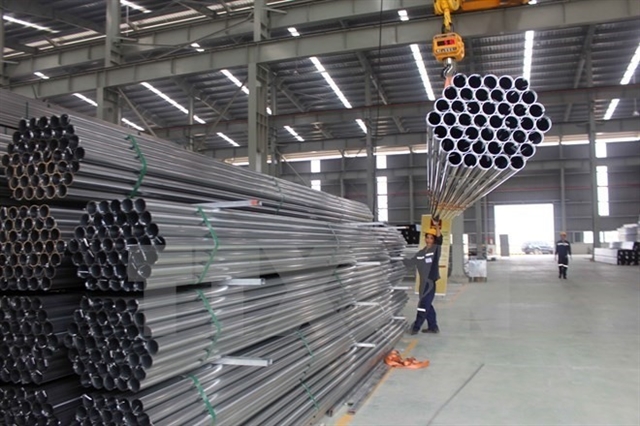 Economy
Economy

 |
| Chinese steel flooding into Việt Nam has been a concern for domestic steel enterprises. — VNA/VNS Photo |
HÀ NỘI — Facing the threat from Chinese steel and the tension of protectionism globally with the possibility of further escalation, whether the 'picture' of the Vietnamese steel industry will be brighter or not in the times ahead continues to form a question mark.
The Trade Remedies Authority of Việt Nam (Trav) under the Ministry of Industry and Trade (MoIT) announced on Wednesday that the US Department of Commerce (DOC) had recently issued the final determination of the US anti-dumping investigation into aluminium extrusions and aluminium products from Việt Nam.
In its final assessment, the department set the weighted-average dumping margin for the mandatory defendant enterprise and 28 firms at 14.15 per cent, 11.3 per cent higher compared to the preliminary conclusion. Other companies will be subject to the national rate based on the margin alleged by the petitioner, which remains at 41.84 per cent.
The Việt Nam Association of Aluminium has been asked to update manufacturers and exporters on the information, while companies must keep a close watch on the case’s developments, study the US policy and antidumping procedures and diversify markets.
On Tuesday the Trav announced that the Australian Anti-Dumping Commission (ADC), under the Australian Department of Industry, Science and Resources, had announced the initiation of an anti-dumping investigation into hot-rolled steel bars, imported or originating from a number of countries, including Việt Nam.
Early this month, the Department of Foreign Trade of Thailand published a notice on the initiation of an anti-dumping investigation on cold-rolled stainless steel products originating or imported from Việt Nam.
Meanwhile, the Canada Border Services Agency (CBSA) announced an extension of the review period for normal value and export price for oil country tubular goods (OCTG) originating or imported from a number of countries, including Việt Nam.
Steel was one of the industries with the largest number of trade defence investigations, not only in Việt Nam but also in the world, said Đinh Quốc Thái, General Secretary of the Việt Nam Steel Association (VSA), at a recent forum on trade defence organised by the MoIT in HCM City.
Regarding Việt Nam's investigation, most recently, the MoIT issued a decision on the results of the final review of the application of anti-dumping measures on some aluminium products originating from China.
Trav has announced the receipt of the final review dossier on the application of anti-dumping measures on some cold-rolled steel products in coils or sheets originating from China.
Additionally, the authority has extended the deadline for submitting the official questionnaire response for foreign manufacturers and exporters in the investigation regarding the application of anti-dumping measures on certain hot-rolled steel products originating from India and China.
China's rapid increase in exports of cheap steel products to many regional markets over the past two years has boosted protectionism worldwide, with the possibility of further escalation.
In a recent report released by Shinhan Securities Việt Nam (SSV), it was stated that Chinese steel flooding into Việt Nam was a real concern for domestic steel enterprises, threatening their recovery.
It is expected that the results of the anti-dumping investigation, expected to be available next month, will reduce the amount of steel imported from China and India flooding into Việt Nam, thereby reducing competitive pressure on importing enterprises.
As data shows, the volume of Chinese steel imported into Việt Nam has nearly doubled over the past two years from 3.76 million tonnes in the first eight months of 2022, to 7.23 million tonnes in the first eight months of this year. This clearly threatens the domestic steel producers.
The SSV said it expected that the amount of steel imported from China might gradually decrease.
This was based on three prospects, it said.
Firstly, China's monetary policy would stimulate the real estate market and boost domestic steel consumption demand, leading to reduced pressure on steel companies in China to look at external markets.
Secondly, China's steel production cuts would increase steel prices and reduce steel exports to other countries because Chinese enterprises would reduce competitive pressure and would not have to find alternative markets to meet their domestic deficit demand.
Thirdly, the expectation was that the results of the anti-dumping investigation, which was expected to be available next month, would reduce the amount of steel imported from China and India into Việt Nam, thereby reducing competitive pressure on importing enterprises.
Analysts also expect that domestic steel enterprises will see better business in the fourth quarter of this year and next year.
Thanks to trade remedies, the Vietnamese steel industry had been able to compete fairly with imported goods on its home turf in recent years, said VSA.
In addition, the steel industry has also built a complete value chain from hot-rolled steel, cold-rolled steel and galvanised steel, with enough capacity to expand exports to other markets. — VNS




